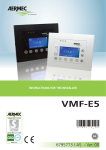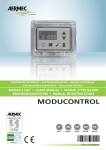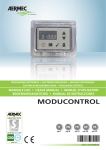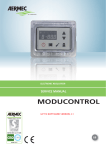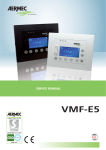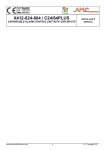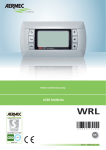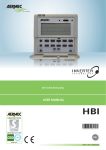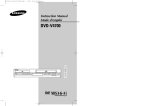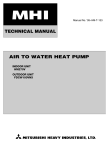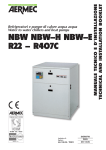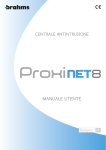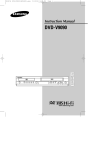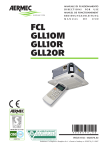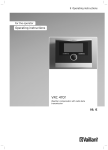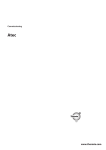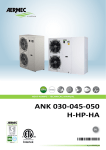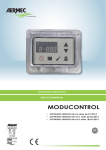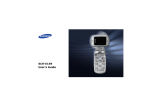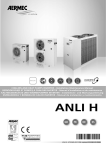Download Aermec Multi Control Technical manual
Transcript
ELECTRONIC REGULATION BOOKLET MULTI CONTROL GB 4598010_00 / A5 - 1201 Index Precautions and Safety Standards ............................................................................................... 5 Type of systems managed by MULTI CONTROL ......................................................................... 6 Systems without additional VMF CRP modules .................................................................................................... 6 Systems with additional VMF CRP modules ......................................................................................................... 7 VMF CRP 1 connections (3-way valves and probes management) ..................................................................... 8 VMF CRP 2 connections (supplementary resistance management on DHW)...................................................... 9 VMF CRP 3 connections (remote control management) .................................................................................... 10 MULTI CONTROL serial connection ........................................................................................... 11 MULTI CONTROL panel user interface ....................................................................................... 12 Interface control keys.......................................................................................................................................... 12 Structure of MULTI CONTROL menus ........................................................................................ 13 Main MULTI CONTROL display.................................................................................................... 14 Main MULTI CONTROL screen ........................................................................................................................... 14 MONITOR mode screen ..................................................................................................................................... 15 BASIC use procedures................................................................................................................. 16 System ON/OFF .................................................................................................................................................. 16 Entering MONITOR mode ................................................................................................................................... 16 Entering menu selection ..................................................................................................................................... 16 Browsing and choice of a menu ......................................................................................................................... 16 UNIT SYNOPTIC menu procedures............................................................................................. 17 Checking status of chillers present in the system .............................................................................................. 17 Reading of characteristic parameters of chillers ................................................................................................ 18 Matching between operating parameters and units ........................................................................................... 19 Setting a daily time period .................................................................................................................................. 20 DOMESTIC HOT WATER SYNOPTIC menu procedures ............................................................ 21 Checking status of chillers for the production of domestic hot water................................................................. 21 Setting a daily time period for the production of domestic hot water ................................................................. 22 Setting the anti-Legionella cycle ......................................................................................................................... 23 User manual - Date time MENU procedures ....................................................................... 24 Setting the time of the system ............................................................................................................................. 24 Setting the date of the system ............................................................................................................................ 25 User manual - SEASON MENU procedures ........................................................................ 26 Setting the season of the system ........................................................................................................................ 26 User manual - DISPLAY MENU procedures ........................................................................ 27 Setting the language of the system .................................................................................................................... 27 Setting the visual contrast of the display ............................................................................................................ 27 Setting the screen saver ..................................................................................................................................... 28 ALARMS MEMORY menu procedures ........................................................................................ 29 Alarm log display ................................................................................................................................................ 29 Description label alerts ....................................................................................................................................... 30 SETUP MENU procedures ........................................................................................................... 31 Entering password for level selection ................................................................................................................. 31 Setup menu - UNIT SETUP procedures ............................................................................... 32 Setting working mode at HEATING (Password 101 or 303)................................................................................ 32 Setting working mode at COOLING (Password 101 or 303) .............................................................................. 33 Setting the compensation function of the working mode (Password 303) ......................................................... 34 Setting the type of units installed (Password 303) .............................................................................................. 35 Setup menu - DHW SETUP procedures............................................................................... 36 Setting number of units for DHW production (Password 303) ............................................................................ 36 Modbus addresses for units for DHW production (without reserve chiller) ........................................................ 37 Modbus addresses for units for DHW production (with reserve chiller) ............................................................. 38 Setting simultaneous loads in DHW production (Password 101 or 303) ............................................................ 39 Setting RAS activation delay for DHW production (Password 101 or 303) ........................................................ 40 Setting diverter valve activation time for DHW production (Password 303) ....................................................... 41 Setting ON/OFF band in DHW production (Password 101 or 303) .................................................................... 42 Setting a hysteresis delta in DHW production with several units (Password 303).............................................. 43 Setting the defrosting direction during DHW production (Password 303).......................................................... 44 Setup menu - SYSTEM SETUP procedures ........................................................................ 45 Setting remote control (Password 101 or 303).................................................................................................... 45 Modbus addresses for the creation of a BMS system ........................................................................................ 46 Setting the baud rate of the serial port of the supervisor (Password 303) ......................................................... 49 Setting the address of the serial port of the supervisor (Password 303) ............................................................ 50 Setting the presence of expansion modules (Password 303) ............................................................................ 51 Viewing network status (Password 101 or 303) .................................................................................................. 52 Setup menu - PLANT SETUP procedures ........................................................................... 53 Setting the number of units installed (Password 303) ........................................................................................ 53 Setting the reserve chiller function (Password 303) ........................................................................................... 54 Setting type of unit rotation (Password 303) ....................................................................................................... 55 Setting the control logic of the units (Password 303) ......................................................................................... 56 Setting ON/OFF delay (Password 101 or 303).................................................................................................... 58 Setting ON/OFF power threshold (Password 101 or 303) .................................................................................. 59 Setting activation with DELTA T control (Password 101 or 303) ......................................................................... 60 Setting deactivation with DELTA T control (Password 101 or 303) ..................................................................... 61 AERMEC S.p.A. I-37040 Bevilacqua (VR) Italy – Via Roma, 996 Tel. (+39) 0442 633111 Telefax 0442 93730 – (+39) 0442 93566 www .aermec. com - info @aermec. com MULTI CONTROL SERIAL NUMBER CE DECLARATION OF CONFORMITY We, the undersigned, hereby declare under our own responsibility that the assembly in question, defined as follows: NAME MULTI CONTROL TYPE Remote panel To which this declaration refers, complies with the following harmonised standards: IEC EN 60730-1 Safety standard IEC EN 61000-6-1 IEC EN 61000-6-3 Immunity and electromagnetic emissions for residential environments Thereby, compliant with the essential requirements of the following directives: - LVD Directive: 2006/95/EC - Electromagnetic Compatibility Directive 2004/108/EC Bevilacqua 15/01/2011 Marketing Manager Signature 4 GB 4598010_00 Precautions and Safety Standards Keep package dry DO NOT step on the packaging Indications regarding waste disposal Handle with care Safety symbols Attention: this product contains electric and electronic appliances that cannot be disposed of through normal municipal collection channels. There are special collection centres for these products. The electric and electronic appliances must be treated separately and in compliance with the laws in force in the country of use. Batteries or accumulators present in the appliances must be disposed of separately according to the provisions of the municipality of use. Voltage hazard Attention Danger moving parts Notes concerning manuals Keep the manuals in a dry place, in order to prevent deterioration, for at least 10 years for any further reference. Read all of the information contained in this manual carefully and completely. Pay particular attention to the user regulations accompanied by “DANGER” or “ATTENTION” in so much as, if not complied with, the unit or objects may be damaged and/or persons injured. For anomalies not contemplated by this manual, contact the area After-sales Service as soon as possible. The appliance must be installed in such a way that maintenance and/or repair operations are possible. The appliance warranty does not cover the costs for ladders, scaffolding, or other elevation systems that may become necessary for carrying out servicing under warranty. AERMEC S.p.A. declines all responsibility for any damage due to improper use of the machine, partial or hasty reading of the information contained in this manual. 4598010_00 GB 5 Type of systems managed by MULTI CONTROL • Systems without additional VMF CRP modules: - System for the production of water only for cooling/heating systems. - Possibility of implementing and managing 2-pipe or 4-pipe systems. - Management of units based on the thermostats of each appliance. - No remote control besides the MULTI CONTROL accessory panel. - Compensation of work setting by means of outdoor air available only on units equipped with outdoor air probe. (*) The MULTI CONTROL accessory manages the units through an RS485 serial connection; for the system to work properly, all the units must be equipped with the MODU485A accessory. RS485 serial connection Unit (1) (*) 6 GB 4598010_00 Unit (2) (*) Unit (3) (*) Unit (4) (*) MULTI CONTROL • Systems with additional VMF CRP modules: - System for production of domestic hot water, managed by 3-way diverter valves, and supplementary electric resistance to reach temperatures suitable for execution of the anti-legionella cycle. - Possibility of implementing and managing 2-pipe or 4-pipe systems. - Management of units based on: • thermostats of each appliance. • DELTA T on system. - Remote control through VMF CRP number 3. - Compensation of work setting through outdoor air available by means of KSAE accessory. MULTI CONTROL (*) The MULTI CONTROL accessory manages the units through an RS485 serial connection; for the system to work properly, all the units must be equipped with the MODU485A accessory. RS485 serial connection SAE (1) A VMF-CRP (2) A Unit (1) (*) Unit (2) (*) Unit (3) (*) Unit (4) (*) A A A A A A (3) B C SUW A A A SIW A SAS A B Component Function VMF CRP (1) Accessory module for management of: - 3-way diverter valves. - System inlet and outlet water probe (SIW, SUW). - DHW storage tank water probe (SAS). - KSAE accessory for outdoor air temperature (SAE). VMF CRP (2) Accessory module for management of supplementary electric resistance in DHW storage tank. VMF CRP (3) Accessory module making it possible to remotely manage some functions: - System On/Off, Alarm reset, Season changeover (via Inputs). - Alarm summary, Alarm presence, System status (ON/OFF), Season status (HEATING/COOLING), Season changeover (via Outputs). 4598010_00 GB 7 • VMF CRP 1 connections (3-way valves and probes management): IL TR1 L 230 24 N 0 0 FUSE 1.25A 24VAC 0VAC 25VA PE 230V~50Hz SIW SAE V3VD (1) V3VD (2) MAX 230V~2A SUW MAX 230V~2A V3VD (3) MAX 230V~2A V3VD (4) MAX 230V~2A SAS 0.34 mm2 (AWG 22) MAX 30m 1.5 mm2 (AWG 16) MAX 30m VMF CRP (1) Serial Address: ON 1 2 3 4 0VAC 0VAC T- 24VAC 24VAC T+ RS 485 GND Code 8 Input to enable probe Available as SIW Primary hydraulic circuit INLET water probe Component ID1 (CLOSED) on terminal board J4 SPLW (1) accessory SUW Secondary hydraulic circuit OUTLET water probe ID2 (CLOSED) on terminal board J4 SPLW (2) accessory SAE External air probe ID3 (CLOSED) on terminal board J4 KSAE accessory SAS DHW storage tank probe ID4 (CLOSED) on terminal board J4 SDHW accessory V3VD (1) 3-way diverter valve unit 1 / Component NOT supplied V3VD (2) 3-way diverter valve unit 2 / Component NOT supplied V3VD (3) 3-way diverter valve unit 3 / Component NOT supplied V3VD (4) 3-way diverter valve unit 4 / Component NOT supplied GB 4598010_00 • VMF CRP 2 connections (supplementary resistance management on DHW): IL TR1 L 230 24 N 0 0 FUSE 1.25A 24VAC 0VAC 25VA PE 230V~50Hz RAS MAX 230V~2A 1.5 mm2 (AWG 16) MAX 30m VMF CRP (2) Serial Address: ON 1 2 3 4 0VAC 0VAC T- 24VAC T+ RS 485 GND ARE Code PRE Component Available as RAS Supplementary electric resistance for DHW Component NOT supplied ARE Resistance alarm presence output CLOSED = Alarm OPEN = No alarm Component NOT supplied PRE Resistance presence output CLOSED = Resistance present in system OPEN = No resistance in system Component NOT supplied 4598010_00 GB 9 • VMF CRP 3 connections (remote control management): IL TR1 L 230 24 N 0 0 FUSE 1.25A 24VAC 0VAC 25VA PE 230V~50Hz AGS SGS MAX 230V~2A MAX 230V~2A SSI ASM MAX 230V~2A MAX 230V~2A 1.5 mm2 (AWG 16) MAX 30m VMF CRP (3) Serial Address: ON 1 2 3 4 0VAC 0VAC T- 24VAC T+ RS 485 GND AGI Code GB 4598010_00 Function CCS Description ASG General System Alarm Closed = Alarm in system Open = No alarm in system SGS General System Status Closed = System ON Open = System OFF SSI System Season Situation Closed = WINTER Open = SUMMER General system alarm Closed = Alarm in progress Open = No alarm in progress AGI General System Enabling Closed = Switch system on Open = Switch system off RGS General System Reset Closed = reset system CCS Season Changeover Control Closed = Set WINTER Open = Set SUMMER ASM 10 RGS MULTI CONTROL serial connection Serial line for BMS supervisor (Modbus) A B GND V2 Power supply B Serial line for BMS supervisor (Modbus) Serial bus GND CN11 A CN12 V1 M1 MULTI CONTROL A B GND M1 IL TR L 230 24 N 0 0 FUSE 0.5A 24VAC 0VAC 25VA CN12 V1 CN11 V2 A B GND PE 230V~50Hz + - GND + MODU485A - GND + MODU485A - GND + MODU485A - GND MODU485A T+ T- GND J3 VMF CRP (1) Unit (1) ! Unit (2) Unit (3) T+ T- GND J3 VMF CRP (2) T+ T- GND J3 VMF CRP (3) Unit (4) ATTENTION: IN ORDER TO BE MANAGED BY THE MULTI CONTROL ACCESSORY, ALL THE UNITS MUST BE SUPPLIED WITH THE ACCESSORY MODU485A BOARD. Information concerning installation of MULTI CONTROL panel: • The MULTI CONTROL panel must be installed indoors. • All of the components required for the power supply (transformers) and to position the panel inside be electric control board, ARE NOT supplied. • We recommend complying with standards in force for installation of the components outside of the MULTI CONTROL panel, entrusting installation to properly trained technical personnel. 4598010_00 GB 11 MULTI CONTROL panel user interface • Interface control keys: The MULTI CONTROL accessory makes it possible to control and manage up to 4 chillers (equipped with MODUCONTROL circuit board). This accessory allows the user to manage: M I L N • Switching units ON/OFF (according to the management logic selected). H • Reading chiller parameters (Working temperatures and pressures, working set-point, etc...). G • Time periods (the system allows to set up to two daily time periods, diversified by days of the week). • Domestic hot water (domestic hot water production, DHW hourly program, anti-legionella cycle, etc...). F E • Functioning modes (heating or cooling mode). • Alarm log (the system allows to record the last 10 alarms triggered in the system). A Key Attention: the use of one or more additional VMF-CRP modules is required to use some functions, as indicated in the system layouts. A B C Function ON/OFF key B C D Multi-function keys; the functionality associated to each one changes according to the page viewed on the display E 12 GB 4598010_00 D F Confirmation key (Enter) G Key for decreasing the value (-) H Key for increasing the value (+) I Backlit white LCD display 128 x 64 pixel L LED not used M LED not used N Red LED for signalling alarm in progress Structure of MULTI CONTROL menus PASSWORD H G A F B I C D L M N PASSWORD: ! E USER password: 101 INSTALLER password: 303 ATTENTION: Incorrect INSTALLER parameter settings can cause the entire system to malfunction; only personnel authorised for assistance or to install the unit is allowed to modify these parameters. ESC Index Menu Description A Unit synoptic B DHW synoptic C User menu This menu contains three submenus D Setup menu This menu contains three submenus parameters protected by password. E Alarms memory F Display menu G Operating season menu H Date time menu In this menu it is possible to set the system time and date. I Chiller/HP setup In this menu it is possible to set the operating parameters of the chillers based on the selected level (USER or INSTALLER). L DHW setup In this menu it is possible to set the chillers for the production of domestic hot water, based on the selected level (USER or INSTALLER). M System setup In this menu it is possible to set the parameters for communication of the MULTI CONTROL accessory with the components of the system (USER or INSTALLER). N Plant setup In this menu it is possible to set management of the chillers for the plant based on the selected level (USER or INSTALLER). This menu gathers all the information regarding the chillers in the system. This menu gathers information concerning production of domestic hot water (this menu is only visible if the system includes production of domestic hot water). F , G I and , L H , where the user can set the basic user parameters. M and N where the user can set the user/installer In this menu, the user can access the log of the last 10 alarms triggered in the system. In this menu it is possible to set the basic features for the graphical interface. In this menu it is possible to select the chiller functioning mode. 4598010_00 GB 13 Main MULTI CONTROL display During normal operation of the system, the MULTI CONTROL accessory display shows the standard window. This window contains information on the system status and this information will allow the user to have a clear indication regarding functioning of the chillers as well as supply any error and/ or malfunctioning messages. • Main MULTI CONTROL screen: Should the user enter a menu and not press any key for a time longer than that set in the screensaver function, the system will automatically return to view the main screen. Icon 14 A B U1 TUA TIA SAE E C 4 D F G 3 2 1 37, 7 C 31, 3 C 10, 1 C O N O O WED 25/11/11 H I ON OFF 11 :23 :06 M L Function A Indicates the status of the system: - if the icon ( ) is present, the system is on; - if no icon is present, the system is off. B Indicates the selected season for the system: - the icon ( ) indicates that the system is working in summer mode; - the icon ( ) indicates that the system is working in winter mode. C Indicates the status of the connected chillers (the number below the symbol indicates which chiller the information refers to): - the icon ( ) indicates that the chiller is on; - the icon ( OFF ) indicates that the chiller is off; - the icon ( SB ) indicates that the chiller is standby mode; - the icon ( ) indicates that the chiller pump is on; - the icon( ) indicates that the chiller is not communicating with the modbus network of the system; - the icon ( ) indicates a failure in the chiller; - the icon ( ) indicates that the chiller is defrosting. D Indicates which chiller the data currently displayed on the main window refers to ( E , F and G ): this parameter could indicate: - U1: indicates that the data refers to chiller 1; - U2: indicates that the data refers to chiller 2; - U3: indicates that the data refers to chiller 3; - U4: indicates that the data refers to chiller 4; - MIX: indicates that the data refers to the SUW and SIW probes of VMF CRP expansion board (1). E Indicates the temperature of the water produced by the chiller currently viewed (the number of the chiller currently viewed as indicated by the parameter D ). F Indicates the inlet temperature of the chiller currently viewed (the number of the chiller currently viewed as indicated by the parameter G Indicates the outside air temperature detected by the chiller currently viewed (the number of the chiller currently viewed as indicated by the parameter D ). H Indicates the day of the week. I Indicates the system date (day/month/year). L Indicates the system time (hours/minutes/seconds). M Indicates whether the time period has been set in the system (for the chiller currently viewed in the parameter N Indicates an alarm status. this indication can represent different situations which can be recognised by the type of icon displayed: - No icon means that no alarms are currently active; - ( ) an alarm not yet viewed in the alarm log is in progress; - ( ) an alarm already viewed in the alarm log is in progress. Should an alarm be triggered, these icons will appear until the cause of the alarm has been found. GB 4598010_00 D ). D ). The MONITOR mode is an additional screen to the main one. It makes it possible to keep the working status of the system chillers under control. • MONITOR mode screen: A The procedure for accessing this screen is explained on the next page (Basic procedures, Enter in MONITOR mode). 1 B 1 2 3 4 TER 025 010 050 025 2 PO 025 010 100 050 C Icon 3 4 TIA TUA +26.0 +21.0 +25.3 +20.5 +25.8 +20.0 +24.9 +20.3 D E Function A Indicates the status of the connected chillers (the number below the symbol indicates which chiller the information refers to): - the icon ( ) indicates that the chiller is on; - the icon ( OFF ) indicates that the chiller is off; - the icon ( SB ) indicates that the chiller is standby mode; - the icon ( ) indicates that the chiller pump is on; - the icon( ) indicates that the chiller is not communicating with the modbus network of the system; - the icon ( ) indicates a failure in the chiller; - the icon ( ) indicates that the chiller is defrosting. B Indicates the percentage of power requested by the thermostat of each chiller (each line is numbered with the chiller index to which it refers). C Indicates the percentage of power supplied by the compressor of each chiller (each line is numbered with the chiller index to which it refers). D Indicates the outlet temperature from each chiller (each line is numbered with the chiller index to which it refers). E Indicates the inlet temperature from each chiller (each line is numbered with the chiller index to which it refers). 4598010_00 GB 15 BASIC use procedures • System ON/OFF: • Entering menu selection: 4 U1 WED TUA TIA SAE 3 2 1 4 U1 37,7 C 31,3 C 10,1 C O TUA TIA SAE O O 25/11/11 ON OFF 11 :23 :06 WED In order to switch the entire system on or off, from the Main screen you must press the indicated key for at least 5 seconds. Attention: the indicated key is active ONLY while the main screen is viewed. 3 2 1 37,7 C 31,3 C 10,1 C 25/11/11 O O O ON OFF 11 :23 :06 To pass from the main screen to the selection of the menus, just press the key indicated in the figure. • Browsing and choice of a menu: • Entering MONITOR mode: UNIT INTERFACE 4 U1 WED TUA TIA SAE 3 2 1 37,7 C 31,3 C 10,1 C 25/11/11 A O O O 11 :23 :06 ON OFF B ESC A D To pass from the main screen to the monitor mode, just press one of the keys indicated in the figure. Once entered in monitor mode, pressing the key ( A ) will return to the main screen, while pressing the key ( B ) will pass on to menu selection. 16 GB 4598010_00 C B Once you have entered the menu selection mode, an icon inside a frame will appear in the centre of the display. This icon represents the menu which can be currently selected (the label of the menu is also viewed at the top of the display); at this moment the possible operations are: - Enter the selected menu (by pressing the A key). - Select the subsequent menu (by pressing the B key). - Select the previous menu (by pressing the C key). - Exit the menu selection mode, returning to the main screen (by pressing the D key). ATTENTION: the succession of the menus is indicated in full in the chapter “structure of the MULTI CONTROL menus”. UNIT SYNOPTIC menu procedures • Checking status of chillers present in the system: The first window of the UNIT SYNOPTIC menu allows the user to monitor the status and settings of the chillers installed in the system; this window displays the following information: UNIT - Chiller currently selected ( 1 ): indicates which chiller the displayed data refers to (1st, 2nd, 3rd or 4th chiller). N:1 A +12.0OC +10.0OC B ESC E ESC D - Chiller status ( 3 ): indicates the status of the chiller currently selected; the symbols which can be viewed are: - the icon ( ) indicates that the chiller is on; - the icon ( OFF ) indicates that the chiller is off; - the icon ( SB ) indicates that the chiller is standby mode; - the icon ( ) indicates that the chiller pump is on; - the icon( ) indicates that the chiller is not communicating with the modbus network of the system; - the icon ( ) indicates that the chiller has an alarm; - the icon ( ) indicates that the chiller is defrosting. C RES - Water outlet temperature ( 4 ): indicates the temperature of the water currently produced by the selected chiller. If the chiller has a fault, the icon ( ) will be replaced by the icon ( ). Furthermore, in place of the temperature value, there will be the alarm code currently active. By pressing the key F a reset control can be sent to the faulty unit. F UNIT - Active functioning mode ( 2 ): indicates which functioning mode is currently set on the chiller selected; the symbols which may be viewed are: - (chiller mode = WINTER). - (chiller mode = SUMMER). N:1 1 - Current work setting ( 5 ): indicates the work setting currently used by the chiller selected. From this window it is possible to: 4 +12.0OC 2 5 +10.0OC 3 (1) Select one of the chillers of the system: by pressing the key C the number of the chiller currently selected is highlighted ( 1 ); after which pressing the key A will pass on to the subsequent chiller, while pressing the key B will select the previous chiller; press the key C to confirm the choice. (2) Enable or disable the selected chiller: by pressing the key D , the chiller can be enabled or disabled; the icons above the key D which represent these two states are: - (represents the ENABLED status); - (represents the DISABLED status). If the unit is ENABLED, it will be managed based on the settings supplied by its work set point and by the eventual hourly program associated; if on the other hand this unit is DISABLED, it will be forced to remain in the OFF status until it is enabled once again. (3) Pass on to the next window: to go to the next window of this menu, press the key B . (4) Exit this window: press the keys A or E to return to the selection of the menus. 4598010_00 GB 17 • Reading of characteristic parameters of chillers: The second window of the UNIT SYNOPTIC menu allows the user to read the values of the main operating parameters of the selected chiller; this window displays the following information: Unit parameters N:1 A TYPE ANL - Chiller currently selected ( 1 ): indicates which chiller the displayed data refers to (1st, 2nd, 3rd or 4th chiller); this choice can ONLY be modified on the page prior to this menu. B ESC - Parameter label ( 2 ): indicates which parameter the displayed value refers to; the table on the next page matches the parameter labels and their descriptions. - Parameter value ( 3 ): indicates the current value of the displayed parameter. E D From this window it is possible to: C (1) Pass on to the next parameter: pressing the key C displays the next parameter, identified by a new label and relative value. Unit parameters TYPE ANL N:1 1 2 3 (2) Go back to the previous parameter: pressing the key D displays the previous parameter, identified by a new label and relative value. (3) Pass on to the next window: to go to the next window of this menu, press the key B . (4) Go back to the previous window: to go back to the previous window of this menu, press the key A . (5) Exit this window: press the E key to return to the selection of the menus. 18 GB 4598010_00 Matching between operating parameters and units: ANR Label Description ANL ANLi ANF ANL-C WRL (1) ANKi SRPV1 TYPE Type of unit ✔ ✔ ✔ (2) ✔ ✔ ✔ TIA Water inlet temperature ✔ ✔ ✔ ✔ ✔ ✔ TUA Water outlet temperature ✔ ✔ ✔ ✔ ✔ ✔ TSB Coil temperature ✔ ✔ ✔ ✔ ✖ ✔ TGP Pressing gas temperature ✔ ✔ ✔ ✔ ✖ ✔ SIWH Condenser inlet water temperature ✖ ✖ ✖ ✖ ✔ ✖ SUWH Condenser outlet water temperature ✖ ✖ ✖ ✖ ✔ ✖ TAE External air temperature ✔ ✔ ✔ ✔ ✔ ✔ AP High pressure ✔ ✔ ✔ ✔ ✔ ✔ BP Low pressure ✔ ✔ ✔ ✔ ✔ ✔ HC0 Primary circuit compressor operating hours ✔ ✔ ✔ ✔ ✔ ✔ SP0 Primary circuit compressor start-ups ✔ ✔ ✔ ✔ ✔ ✔ REL Software relay (MAIN) ✔ ✔ ✔ ✔ ✔ ✔ BLD Software relay (SECONDARY) ✔ ✔ ✔ ✔ ✔ ✔ SET Current work setting of chiller ✔ ✔ ✔ ✔ ✔ ✔ HC1 Secondary circuit compressor operating hours ✔ ✔ ✔ ✔ ✔ ✔ SP1 Secondary circuit compressor start-ups ✔ ✔ ✔ ✔ ✔ ✔ STF Set-point at cooling ✔ ✔ ✔ ✔ ✔ ✔ STC Set-point at heating ✔ ✔ ✔ ✔ ✔ ✔ SAS Set-point at DHW ✔ ✔ ✔ ✔ ✔ ✔ PT Power percentage requested by the thermostat ✔ ✔ ✔ ✔ ✔ ✔ PO Power supply by unit (On-Off) or frequency in use (units with inverter compressors) ✔ ✔ ✔ ✔ ✔ ✔ (1) Only models with MODUCONTROL board (WRL cooling only from size 025 to size 160). (2) For these units, the TYPE parameter will read the generic R407. Parameter present = ✔ Parameter NOT present = ✖ 4598010_00 GB 19 • Setting a daily time period: The third window of the UNIT SYNOPTIC menu allows the user to set daily time periods (maximum of two for each day of the week) for the chiller currently selected; once the time periods have been activated, the chiller will only run during the time periods (in the set mode), while outside of them it will be off; this window displays the following information: Unit timer On Off ESC N:1 Sunday 10:00 15:30 12:10 18:00 A B COPY C - Chiller currently selected ( 1 ): indicates which chiller the displayed data refers to (1st, 2nd, 3rd or 4th chiller); this choice can ONLY be modified on the first page of this menu. - Day of the week ( 2 ): indicates which day of the week is managed by the specified time periods. - First time period ON ( 3 ): indicates the time at which the first time period must start. G D F - First time period OFF ( 4 ): indicates the time at which the first time period must end. E - Second time period ON ( 5 ): indicates the time at which the second time period must start. 2 Unit timer 1 - Second time period OFF ( 6 ): indicates the time at which the second time period must end. N:1 Sunday From this window it is possible to: On 10:00 15:30 5 Off 12:10 18:00 6 3 4 (1) Activate or deactivate the time periods for the chiller currently selected: to activate or deactivate the time periods for the chiller currently selected, press the key F ; pressing this key will change the symbol highlighted above it according to one of the following states: - ( ) time periods DISABLED for the selected chiller; - ( ) time periods ENABLED for the selected chiller. If at least one chiller of the system has the time periods enabled, the symbol ( ) will appear on the main window. ON OFF ! ATTENTION: The setting of the time periods must have coherent data; the logic to be respected can be summarised with the following relation: 3 < 4 < 5 < 6 If this relation is not respected, when all the data has been entered a “DATA ERROR” message will appear on the display, disabling the entire daily time period. If you would like to delete one or more time periods, it is necessary to set the start and end of that time period at 00:00. (2) Select a day of the week at which to set the time periods: pressing the key E will make it possible to scroll all the days of the week; the day currently selected will appear at the top part of the display ( 2 ). (3) Set the time periods for the selected day: pressing the key C will allow you to enter modification mode and the starting TIME for the first daily time period will be highlighted; at this point, the procedure for setting the time periods will be: a) press the keys A or B to increase or decrease the selected value. b) press the key C to confirm and pass on to the subsequent data. If you wish to set only one daily time period, you must set 00:00 for the start ( 5 ) and for the end ( 6 ) of time period two. (4) Disable the time periods for the selected day: to disable the time periods on the selected day, ALL time period start and end values must be set at 00:00. (5) Copy the time periods of the day currently selected on ALL the days of the week: to copy the same settings as the day currently displayed for ALL days of the week, press the key D . (6) Go back to the previous window: to go back to the previous window of this menu, press the key A . (7) Exit this window: press the G key to return to the selection of the menus. 20 GB 4598010_00 DOMESTIC HOT WATER SYNOPTIC menu procedures • Checking status of chillers for the production of domestic hot water: The first window of the DHW SYNOPTIC menu allows the user to monitor the status and settings for production of domestic hot water in the system; this window displays the following information: SANITARY WATER A 25.3 C o 40.0oC B ESC C F D E 25.3oC 3 4 40.0oC 2 - Set temperature for DHW ( 2 ): Indicates the temperature the system must bring the water inside the DHW storage tank to. - Status of water production from heat pump( 3 ): indicates the status of the heat pump, which can be: - Fixed image ( ) (this means that the heat pump is not active). - Flashing image ( ) (this means that the heat pump is active). SANITARY WATER 1 - DHW storage temperature ( 1 ): indicates the current temperature detected inside the DHW storage tank. - Status of integration for domestic hot water( 4 ): indicates the status of any integrations to DHW; the integration can be performed by means of an electrical resistance or a boiler; the supplementary heat sources are represented in the system by the same symbol, which can be: - NOT DISPLAYED (this means that no supplementary heat source for the production of domestic hot water has been installed). - Fixed image ( ) (this means that the supplementary heat source is not active). - Flashing image ( ) (this means that the supplementary heat source is active). 5 ! ATTENTION: this menu is displayed only if the system has heat pumps suitable for the production of domestic hot water. To manage the production of domestic hot water in a suitable fashion, at least two VMF-CRP modules must be inserted in the system (one for management of the 3-way diverter valves and the other for management of the supplementary electric resistance). - DHW system indications ( 5 ): this area indicates particular states during the production of domestic hot water: - ( ) indicates the absence of communication between the MULTI CONTROL accessory and the heat pump. - ( ) indicates that the anti-legionella cycle is currently in progress. From this window it is possible to: (1) Activate or deactivate the production of domestic hot water: to activate or deactivate the production of domestic hot water, press the key D ; pressing this key will change the symbol highlighted above it according to one of the following states: - ( ) function DISABLED; - ( ) function ENABLED. (2) Setting domestic hot water: pressing the key C will allow you to enter the modification mode and the value will be highlighted; by pressing the keys A or B it will be possible to modify the set value, while pressing the key C will confirm this choice. (3) Manually activate or deactivate the integrative heat source: to manually activate or deactivate a supplementary heat source, press the key E ; pressing this key will change the symbol highlighted above it according to one of the following states: - ( ) supplementary heat source DEACTIVATED; - ( ) supplementary heat source ACTIVATED. (4) Pass on to the next window: to go to the next window of this menu, press the key B . (5) Exit this window: press the keys A or F to return to the selection of the menus. 4598010_00 GB 21 • Setting a daily time period for the production of domestic hot water: The second window of the DHW SYNOPTIC menu allows the user to set daily time periods (maximum of two for each day of the week) for DHW production; when the time periods are activated, the heat pump will only produce hot water during the time periods; this window displays the following information: D.H.W. timer A Sunday On Off ESC 10:00 15:30 12:10 18:00 - Day of the week ( 1 ): indicates which day of the week is managed by the specified time periods. B COPY C - First time period ON ( 2 ): indicates the time at which the first time period must start. - First time period OFF ( 3 ): indicates the time at which the first time period must end. - Second time period ON ( 4 ): indicates the time at which the second time period must start. G D F E - Second time period OFF ( 5 ): indicates the time at which the second time period must end. From this window it is possible to: 1 D.H.W. timer Sunday On 10:00 15:30 4 Off 12:10 18:00 5 2 ! 3 ATTENTION: The setting of the time periods must have coherent data; the logic to be respected can be summarised with the following relation: 2 < 3 < 4 < 5 If this relation is not respected, when all the data has been entered a “DATA ERROR” message will appear on the display, disabling the entire daily time period. If you would like to delete one or more time periods, it is necessary to set the start and end of that time period at 00:00. (1) Activate or deactivate the time periods for the production of DHW: to activate or deactivate the time periods for the chiller currently selected, press the key F ; pressing this key will change the symbol highlighted above it according to one of the following states: - ( ) time periods DISABLED; - ( ) time periods ENABLED. If the system has the time periods enabled, the symbol ( ) will appear on the main window. ON OFF (2) Select a day of the week at which to set the time periods: pressing the key E will make it possible to scroll all the days of the week; the day currently selected will appear at the top part of the display ( 1 ). (3) Set the time periods for the selected day: pressing the key C will allow you to enter modification mode and the starting TIME for the first daily time period will be highlighted; at this point, the procedure for setting the time periods will be: a) press the keys A or B to increase or decrease the selected value. b) press the key C to confirm and pass on to the subsequent data; If you wish to set only one daily time period, you must set 00:00 for the start ( 4 ) and for the end ( 5 ) of time period two. (4) Disable the time periods for the selected day: to disable the time periods on the selected day, ALL time period start and end values must be set at 00:00. (5) Copy the time periods of the day currently selected on ALL the days of the week: to copy the same settings as the day currently displayed for ALL days of the week, press the key D . (6) Go back to the previous window: to go back to the previous window of this menu, press the key A . (7) Pass on to the next window: to go to the next window of this menu, press the key B . (8) Exit this window: press the G key to return to the selection of the menus. 22 GB 4598010_00 • Setting the anti-Legionella cycle: The third window of the DHW SYNOPTIC menu allows the user to set the time and days on which to carry out the anti-legionella cycle; this window displays the following information: Legionella treatment A 22:16 MON TUE WED THU FRI SAT - Anti-legionella cycle starting time ( 1 ): indicates the time at which the anti-legionella cycle will be carried out (for all the days selected). SUN B ESC C - Days on which to carry out the anti-legionella cycle ( 2 ): indicates the days on which the anti-legionella cycle must be carried out. From this window it is possible to: E D Legionella treatment 22:16 MON ! TUE WED THU FRI 1 SAT SUN ATTENTION: In systems which use a storage tank for the production of domestic hot water, the anti-Legionella cycle must be ACTIVE. TO CORRECTLY EXECUTE THE ANTILEGIONELLA CYCLE, THE SYSTEM MUST HAVE A SUPPLEMENTARY HEAT SOURCE (RESISTANCE OR BOILER) BY MEANS OF WHICH IT IS POSSIBLE TO REACH THE TEMPERATURE NECESSARY FOR THE ANTI-LEGIONELLA CYCLE (65°C). 2 (1) Set the anti-legionella cycle: pressing the key C will allow you to enter modification mode and the starting TIME for the antilegionella cycle will be highlighted; at this point, the procedure for setting the anti-legionella cycle will be: a) Press the key A to increase the selected value or the key B to decrease it. b) Press the key C to confirm the selection and pass on to set the minutes. c) Press the key A to increase the selected value or the key B to decrease it. d) Press the key C to confirm the selection and to pass on to set the days in which the cycle will be performed; the first day of the week will be highlighted. e) Press the key A or B to select ( ) or to clear ( ) the day highlighted. f) Press the key C to confirm the selection and pass on to set the next day. g) Repeat points (f) and (g) for all the days of the week; after having confirmed the selection or cleared Friday, the setting of the anti-legionella cycle will be concluded. (2) Activate or deactivate the anti-legionella cycle: to activate or deactivate the anti-legionella cycle, press the key D ; pressing this key will change the symbol highlighted above it according to one of the following states: - ( ) anti-legionella cycle DISABLED; - ( ) anti-legionella cycle ENABLED. (3) Go back to the previous window: to go back to the previous window of this menu, press the key A . (5) Exit this window: press the E key to return to the selection of the menus. 4598010_00 GB 23 User manual - Date time MENU PROCEDURES • Setting the time of the system: The first window of the DATE TIME MENU allows the user to set the time of the system; this window displays the following information: - Current time set in the system ( 1 ): indicates the time set for the system; all the timers of the MULTI CONTROL panel will be managed by using the time set in this parameter. System clock A From this window it is possible to: 08:26:15 B ESC C D System clock 08:26:15 1 (1) Set system time: pressing the key C will allow you to enter modification mode and the TIME will be highlighted; at this point, the procedure for setting the system time will be: a) Press the key A to increase the hour or the key B to decrease it. b) Press the key C to confirm the selection and pass on to set the minutes. c) Press the key A to increase the selected value or the key B to decrease it. d) Press the key C to confirm the selection and pass on to set the seconds. c) Press the key A to increase the selected value or the key B to decrease it. d) Press the key C to confirm the selection and exit time modification mode. (2) Pass on to the next window: to go to the next window of this menu, press the key B . (3) Exit this window: press the key A to return to the selection of the USER menus. (4) Exit this window: press the key D to return to the selection of the main menus. 24 GB 4598010_00 • Setting the date of the system: The second window of the DATE TIME MENU allows the user to set the date of the system; this window displays the following information: - Current date set in the system ( 1 ): indicates the date set for the system; all the timers of the MULTI CONTROL panel will be managed by using the date set in this parameter. System date A 13/03/11 From this window it is possible to: Monday B ESC C D System date 13/03/11 Monday 1 2 (1) Set system date: pressing the key C will allow you to enter modification mode and the DAY will be highlighted; at this point, the procedure for setting the system date will be: a) Press the key A to increase the day or the key B to decrease it. b) Press the key C to confirm the selection and pass on to set the month. c) Press the key A to increase the selected value or the key B to decrease it. d) Press the key C to confirm the selection and pass on to set the year. e) Press the key A to increase the selected value or the key B to decrease it. f) Press the key C to confirm the selection and pass on to set the day of the week. g) Press the key A to increase the selected value or the key B to decrease it. h) Press the key C to confirm the selection and exit date modification mode. (2) Go back to the previous window: to go back to the previous window of this menu, press the key A . (3) Exit this window: press the key D to return to the selection of the main menus. 4598010_00 GB 25 User manual - SEASON MENU PROCEDURES • Setting the season of the system: The first window of the SEASON MENU allows the user to set the functioning mode; this window displays the following information: A - Season set in the system ( 1 ): indicates the season set for the system; the chillers of the system will be managed according to that set in this parameter (if the functioning logic foresees it). B From this window it is possible to: Season WINTER ESC C D (2) Exit this window: press the key A to return to the selection of the USER menus. Season WINTER 26 GB 4598010_00 (1) Set system season: pressing the key C will allow you to enter the modification mode and the season will be highlighted; by pressing the keys A or B it will be possible to modify the season, while pressing the key C will confirm this choice; the values possible are: - WINTER (heating mode; this mode is only possible if the units of the system are heat pumps or heating only units). - SUMMER (cooling mode; this mode is NOT possible if the units of the system are heat pumps or heating only units). 1 (3) Exit this window: press the key D to return to the selection of the main menus. User manual - DISPLAY MENU PROCEDURES • Setting the language of the system: The first window of the DISPLAY MENU allows the user to set the interface language; this window displays the following information: - Language set in the system ( set for the system interface. 1 ): indicates the language Language A From this window it is possible to: B (1) Set system language: pressing the key C will allow you to enter the modification mode and the language will be highlighted; by pressing the keys A or B it will be possible to modify the language, while pressing the key C will confirm this choice. ENGLISH ESC C (2) Exit this window: press the key A to return to the selection of the USER menus. (3) Pass on to the next window: to go to the next window of this menu, press the key D . (4) Exit this window: press the key D to return to the selection of the main menus. Language ENGLISH B 1 • Setting the visual contrast of the display: The second window of the DISPLAY MENU allows the user to set the display contrast mode; this window displays the following information: - Display contrast ( 1 ): indicates the percentage of contrast currently defined for the display. Contrast of the LCD A From this window it is possible to: B (1) Set the display contrast: pressing the key C will allow you to enter the modification mode and the value will be highlighted; by pressing the keys A or B it will be possible to modify the contrast value, while pressing the key C will confirm this choice. 030% ESC C (2) Go back to the previous window: to go back to the previous window of this menu, press the key A . D (3) Pass on to the next window: to go to the next window of this menu, press the key Contrast of the LCD 030% B . (4) Exit this window: press the key D to return to the selection of the main menus. 1 4598010_00 GB 27 • Setting the screen saver: The third window of the DISPLAY MENU allows the user to set the idle time after which the screen saver will be activated (namely return automatically to the main screen); this window displays the following information: - Screen saver activation time ( 1 ): indicates the idle time after which the screen saver switches on. Screen saver A From this window it is possible to: 60 min B ESC C (2) Go back to the previous window: to go back to the previous window of this menu, press the key A . D (3) Exit this window: press the key D to return to the selection of the main menus. Screen saver 60 min 28 GB (1) Set the activation time of the screen saver: pressing the key C will allow you to enter the modification mode and the value will be highlighted; by pressing the keys A or B it will be possible to modify the value, while pressing the key C will confirm this choice. 4598010_00 1 ALARMS MEMORY menu procedures • Alarm log display: The windows of the ALARMS MEMORY menu allow the user to view the cards of the last ten alarms triggered in the system; this window displays the following information: Allarm n:10 Unit 1 A - Unit from which the alarm was triggered ( 1 ): indicates which unit the alarm described in the card currently displayed refers to. Not connected 16:09 24/04/11 ESC B CLR C E - Alarm label ( 3 ): indicates the type of alarm which occurred; this label makes the alarm easy to recognise, the list of which is carried in the table on the next page. D 1 Allarm 2 - Time and date of the alarm ( date when the alarm occurred. n:10 4 ): indicates the time and From this window it is possible to: Unit 1 Not connected 3 16:09 4 24/04/11 - Alarm card index ( 2 ): indicates the index of the alarm card currently displayed; the alarm memory can contain a maximum of 10 alarm cards, displayed in chronological order (from the most to the least recent), therefore the first card displayed will have a larger index; each new alarm (after the first 10) automatically cancels the card of the oldest alarm recorded (namely the alarm with index 1). (1) Scroll the alarm cards: the alarm log can store a maximum of 10 alarm cards (each card represents one alarm), displayed in chronological order (therefore from the larger to the smaller index); to scroll the cards, it is necessary to: a) Press the key A to go back to the previous card. b) Press the key B to pass on to the next card. (2) Cancel the alarm log: press the key log. D to cancel the alarm ATTENTION: cancelling the alarm log DOES NOT reset the alarm, but only cancels its history card. (3) Exit this window: press the keys A or E to return to the selection of the menus. 4598010_00 GB 29 Description label alerts: Origin of alarm (1) Alarm label (2) System EEPROM error Incorrect initialisation of MULTI CONTROL panel memory. Not connected Unit not connected to MULTI CONTROL RS485 network. AL XXXX (in this case the code associated to the alarm is transmitted by the chiller board; for further Alarm defined by unit. information concerning chiller alarm codes, refer to the user manual of the unit) Unit (n°) No anti-legionella The anti-legionella cycle did not conclude properly. No hot water The domestic hot water production cycle did not conclude properly. Incorrect DHW setting The operating setting is greater than the maximum operating temperature of the HP and there is no RAS. Exp not connected Expansion board not connected to MULTI CONTROL RS485 network. SUW probe faulty Mix water outlet temperature probe faulty. SIW probe faulty Mix water inlet temperature probe faulty. SAS probe faulty DHW probe faulty. SAE probe faulty External air temperature probe faulty. Exp not connected Expansion board not connected to MULTI CONTROL RS485 network. Resistance faulty RAS resistance broken. Exp not connected Expansion board not connected to MULTI CONTROL RS485 network. DHW VMF CRP 1 VMF CRP 2 VMF CRP 3 (1) This parameter is displayed in the alarm cards at index ( 1 ). (2) This parameter is displayed in the alarm cards at index ( 3 30 GB Description 4598010_00 ). SETUP MENU procedures • Entering password for level selection: Insert password A 000 VS:1.0.0 B ESC C The first window of the SETUP MENU allows the user to enter the password to access the protected parameters of the MULTI CONTROL device; there are two levels: - USER level (contains the operating parameters which can freely be set by the user). - INSTALLER level (contains both the operating parameters of the user level and the specific parameters the setting or modification of which is RESERVED to installation or assistance personnel of the units insofar as an incorrect setting of the values in these parameters could cause the units to be damaged or malfunction); this window displays the following information: - Password ( 1 ): indicates the password to access the various submenus. - Software version ( 2 ): indicates the software version currently installed on the device. D From this window it is possible to: Insert password 000 VS:1.0.0 ! The password values are: 1 2 (1) Enter an access password: pressing the key C will allow you to enter the modification mode and the value of the password will be highlighted; by pressing the keys A or B it will be possible to modify the first digit, while pressing the key C will confirm the value, automatically selecting the next digit; the selection and confirmation procedure will be repeated for all three digits; after the third digit has been confirmed, you will access the submenus of the level to which the password referred, or, if the password is incorrect, an error message will appear. (3) Exit this window: press the keys A or D to return to the selection of the menus. USER LEVEL = 101 INSTALLER LEVEL = 303 4598010_00 GB 31 Setup menu - UNIT SETUP procedures • Setting working mode at HEATING (Password 101 or 303): The first window of the UNIT SETUP allows the user to set the working mode at heating (valid if heat pump units or heating only units are installed in the system); this window displays the following information: Hot setpoint - Index of the unit to which the setting refers ( 1 ): indicates which unit (1, 2, 3 or 4) the work setting refers to. N:1 A 45.0oC B - Heating setting ( 2 ): indicates the heating operating setpoint of the units managed by MULTI CONTROL. ESC C From this window it is possible to: (1) Select a unit to set at heating mode: pressing the keys D or E decreases or increases the index which indicates which unit the work setting currently displayed refers to ( 1 ); remember that each unit can be set with different work settings. F E D Hot setpoint o 45.0 C N:1 1 (2) Setting at heating mode: pressing the key C will allow you to enter the modification mode and the value will be highlighted; by pressing the keys A or B it will be possible to modify the set value, while pressing the key C will confirm this choice. (3) Pass on to the next window: to go to the next window of this menu, press the key B . 2 (4) Exit this window: press the key A to return to the selection of the SETUP menus. (5) Exit this window: press the key F to return to the selection of the USER menus. 32 GB 4598010_00 • Setting working mode at COOLING (Password 101 or 303): The second window of the UNIT SETUP allows the user to set the working mode at cooling (invalid if heating only units are installed in the system); this window displays the following information: Cold setpoint - Index of the unit to which the setting refers ( 1 ): indicates which unit (1, 2, 3 or 4) the work setting refers to. N:1 A 12.0oC B - Cooling setting ( 2 ): indicates the cooling operating setpoint of the units managed by MULTI CONTROL. ESC C From this window it is possible to: (1) Select a unit to set at cooling mode: pressing the keys D or E decreases or increases the index which indicates which unit the work setting currently displayed refers to ( 1 ); remember that each unit can be set with different work settings. F E D Cold setpoint o 12.0 C N:1 1 (2) Setting at cooling mode: pressing the key C will allow you to enter the modification mode and the value will be highlighted; by pressing the keys A or B it will be possible to modify the set value, while pressing the key C will confirm this choice. (3) Pass on to the next window: to go to the next window of this menu, press the key B . 2 (4) Go back to the previous window: to go back to the previous window of this menu, press the key A . (5) Exit this window: press the key F to return to the selection of the USER menus. 4598010_00 GB 33 • Setting the compensation function of the working mode (Password 303): The third window of the UNIT SETUP allows the installer to set the compensation function on the work setting based on the external air temperature; this window displays the following information: Climatic setpoint TAext A TWout o o o o -05.0 C +40.0 C +15.0 C +35.0 C B ESC C F E 2 Climatic setpoint 5 TAext TWout o o o o -05.0 C +40.0 C +15.0 C +35.0 C 3 4 From this window it is possible to: (1) Select compensation at heating or at cooling: by pressing the key D the data displayed will pass from that referred to heating compensation to that referred to cooling; this data is identified by the relative labels ( 5 ). TAE 3 1 2 ! TUA 4 ATTENTION: 1 < 3 , 2 < 4 Compensation logic at HEATING: TAE 3 (2) Set the values for the compensation function: pressing the key C will allow you to enter the modification mode and the value ( 1 ) will be displayed; by pressing the keys A or B it will be possible to modify the value, while pressing the key C will confirm the choice, automatically selecting the value ( 2 ), which can be modified the same way as the previous value; whenever a value is confirmed by pressing the key C , the next value will be selected until all four values have been entered. (3) Activate or deactivate the compensation function: to activate or deactivate compensation (both heating and cooling, as it is not possible to activate or deactivate them individually), press the key E ; when this key is pressed, the symbol highlighted above it will change, according to one of the following states: - ( ) compensation DISABLED; - ( ) compensation ENABLED. (3) Pass on to the next window: to go to the next window of this menu, press the key 4 ! 2 ATTENTION: 1 < 3 , 2 . TUA > (5) Exit this window: press the key F to return to the selection of the USER menus. TAE = External air temperature. TUA = Produced water temperature. 4598010_00 B (4) Go back to the previous window: to go back to the previous window of this menu, press the key A . 1 GB - Work setting value (2) ( 4 ): indicates the minimum or maximum work setting value (depending on the heating or cooling functioning mode) connected to the MAXIMUM external air value. - Compensation label ( 5 ): indicates whether the data displayed refers to cooling or heating compensation: - compensation at COOLING ( ); - compensation at HEATING ( ). Compensation logic at COOLING: 34 - Work setting value (1) ( 2 ): indicates the maximum or minimum work setting value (depending on the heating or cooling functioning mode) connected to the MINIMUM external air value. - External air temperature value (2) ( 3 ): indicates the maximum external air temperature value which the compensation function refers to; depending on the functioning mode (heating or cooling) this value will be connected to the minimum or maximum produced water setting, as indicated in the curves below. D 1 - External air temperature value (1) ( 1 ): indicates the minimum external air temperature value which the compensation function refers to; depending on the functioning mode (heating or cooling) this value will be connected to the maximum or minimum produced water setting, as indicated in the curves below. 4 • Setting the type of units installed (Password 303): The fourth window of the UNIT SETUP allows the user to set the type of unit installed in the system; this window displays the following information: Type of unit - Index of the unit to which the type of unit refers ( 1 ): indicates which unit (1, 2, 3 or 4) the data currently displayed refers to. N:1 A CHILLER B - Type of unit ( 2 ): indicates which type of unit has been installed (numbered in the system based on the index 1 ). ESC C From this window it is possible to: (1) Select a unit for which to set the type: pressing the keys D or E decreases or increases the index indicating which unit the work setting currently displayed refers to ( 1 ). F E Type of unit D N:1 1 2 CHILLER (2) Setting type: pressing the key C will allow you to enter the modification mode and the value will be highlighted; by pressing the keys A or B it will be possible to modify the parameter value, while pressing the key C will confirm this choice; the types of units possible are: - COOLING ONLY. - HEATING ONLY. - HEAT PUMP. Obviously if the system only has COOLING ONLY units, all the settings linked to heating and DHW production will be deactivated. (3) Go back to the previous window: to go back to the previous window of this menu, press the key A . (4) Exit this window: press the key F to return to the selection of the USER menus. 4598010_00 GB 35 Setup menu - DHW SETUP procedures • Setting number of units for DHW production (Password 303): The first window of the DHW SETUP allows the installer to set the number of units producing domestic hot water; this window displays the following information: DHW units A 2 - Number of units to produce DHW ( 1 ): indicates which units will be used to produce domestic hot water; this parameter also includes any reserve units (if the relative parameter specifies their presence: Setup menu - SYSTEM SETUP procedures - Presence of reserve chiller). B ESC From this window it is possible to: C D (1) Set the number of units for DHW production: pressing the key C will allow you to enter the modification mode and the value will be highlighted; by pressing the keys A or B it will be possible to modify the value currently displayed, while pressing the key C will confirm this choice. (2) Pass on to the next window: to go to the next window of this menu, press the key . (3) Exit this window: press the key A to return to the selection of the SETUP menus. DHW units 2 B 1 (4) Exit this window: press the key D to return to the selection of the USER menus. ATTENTION: to correctly set management of units for DHW production, the following guidelines must be respected: (1) Modbus address of units: the units must have a specific modbus address to be able to be managed properly by the MULTI CONTROL accessory; this address can only be set from the panel on the unit (for further information on procedures for setting a serial address on the units, refer to its user manual); the addresses to be set on the units depend on the number and function which the units perform in the system; to clarify which are the correct addresses to be applied to the units for DHW production, see the summary table on the next page. (2) Type of unit: if the system is provided with a reserve chiller, this unit will be the one with the highest modbus address (as indicated in the summary table on the next page); moreover, if the system envisions the both possibility of a reserve chiller and DHW production enabling, ALL the units of the system must be capable of producing domestic hot water (therefore they must all be heat pumps or heating only units). 36 GB 4598010_00 Modbus addresses for units for DHW production (without reserve chiller): Type of systems for DHW production: The first three types of systems have one or more units for DHW production, however they can have other COOLING ONLY chillers for the system (MULTI CONTROL manages a maximum of 4 units); in this case, it is MANDATORY that the units used for production of domestic hot water be set with the addresses specified in this table and that eventual cooling only chillers be set with the serial addresses remaining available. Remember that to identify the units managed by MULTI CONTROL, the addresses available are: Unit number 1 = Modbus Address 200. Unit number 2 = Modbus Address 201. Unit number 3 = Modbus Address 202. Unit number 4 = Modbus Address 203. Number of units for DHW Modbus serial addresses (1) Type of system 1 2 3 4 200 / / / 200 201 / / 200 201 202 / 200 201 202 203 1 1 DHW storage tank 1 2 2 DHW storage tank 1 2 3 3 DHW storage tank 1 2 3 4 4 DHW storage tank (1) The Modbus serial addresses must be set on the units by means of their on-board control panel. 4598010_00 GB 37 Modbus addresses for units for DHW production (with reserve chiller): Type of systems for DHW production: In these types of units where DHW also has a reserve unit, ALL the units managed by MULTI CONTROL must be capable to produce domestic hot water (HEAT PUMPS or HEATING ONLY); the reserve unit is always the last one, namely the one with the highest serial address; this unit will not be activated during the request for domestic hot water, but will only intervene if one or more of the main units are unusable. Remember that to identify the units managed by MULTI CONTROL, the addresses available are: Unit number 1 = Modbus Address 200. Unit number 2 = Modbus Address 201. Unit number 3 = Modbus Address 202. Unit number 4 = Modbus Address 203. Number of units for DHW Modbus serial addresses (1) Type of system 1 2 3 4 200 / / / 200 201 Reserve / / 200 201 202 Reserve / 200 201 202 203 Reserve 1 1 DHW storage tank 1 2 2 DHW storage tank 1 2 3 3 DHW storage tank 1 2 3 4 4 DHW storage tank (1) 38 The Modbus serial addresses must be set on the units by means of their on-board control panel. GB 4598010_00 • Setting simultaneous loads in DHW production (Password 101 or 303): The second window of the DHW SETUP allows the user to set consent for simultaneous loads in the system; this function will make it possible to simultaneously activate (or to prevent this possibility) both the unit (compressor and electric resistance inside the unit) and the supplementary electric resistance RAS inside the DHW storage tank; this window displays the following information: Enable load A ON B ESC C - Simultaneous load enabling ( 1 ): indicates the current status of simultaneous load enabling during the production of domestic hot water. From this window it is possible to: (1) Enable or disable simultaneous loads: pressing the key C will allow you to enter the modification mode and the value will be highlighted; by pressing the keys A or B it will be possible to modify the value currently displayed, while pressing the key C will confirm this choice; the values that can be set are: - ON (Enable simultaneous loads); - OFF (Disable simultaneous loads). D (2) Pass on to the next window: to go to the next window of this menu, press the key Enable load ON 1 B . (3) Go back to the previous window: to go back to the previous window of this menu, press the key A . (4) Exit this window: press the key F to return to the selection of the USER menus. 4598010_00 GB 39 • Setting RAS activation delay for DHW production (Password 101 or 303): The third window of the DHW SETUP allows the user to set the delay in activation of the RAS (DHW storage tank resistance); this function will make it possible to activate the RAS after a set amount of time if in the meantime the unit has not met the DHW demand; this window displays the following information: Delay switch on RAS A 00 min B - RAS switch-on delay time ( 1 ): indicates the time currently set before the RAS switches on for the production of domestic hot water; if set at 0, the function is disabled. ESC C From this window it is possible to: (1) Set an RAS switch-on delay time: pressing the key C will allow you to enter the modification mode and the value will be highlighted; by pressing the keys A or B it will be possible to modify the value currently displayed, while pressing the key C will confirm this choice. D (2) Pass on to the next window: to go to the next window of this menu, press the key Delay switch on RAS 00 min B . (3) Go back to the previous window: to go back to the previous window of this menu, press the key A . (4) Exit this window: press the key F to return to the selection of the USER menus. 1 40 GB 4598010_00 • Setting diverter valve activation time for DHW production (Password 303): The fourth window of the DHW SETUP allows the installer to set the rotation time of the 3-way diverter valve; this function will keep the unit from triggering a flow switch alarm during rotation of the 3-way diverter valve (this valve is used to divert the production of water from the system to the DHW storage tank); this window displays the following information: V3V timing rotation A 020 sec B ESC C - Diverter valve rotation time ( 1 ): indicates the time of rotation of the diverter valves installed in the system; within this time range, the heat pump which is activated for the production of domestic hot water is OFF to avoid problems with the flow switch. From this window it is possible to: (1) Set a rotation time for the diverter valve: pressing the key C will allow you to enter the modification mode and the value will be highlighted; by pressing the keys A or B it will be possible to modify the value currently displayed, while pressing the key C will confirm this choice. D V3V timing rotation 020 sec (2) Pass on to the next window: to go to the next window of this menu, press the key B . (3) Go back to the previous window: to go back to the previous window of this menu, press the key A . (4) Exit this window: press the key F to return to the selection of the USER menus. 1 4598010_00 GB 41 • Setting ON/OFF band in DHW production (Password 101 or 303): The fifth window of the DHW SETUP allows the user to set the DHW production ON/OFF band; this function makes it possible to set the minimum and maximum deviation from the domestic hot water setting, in order to activate or deactivate DHW demand; this window displays the following information: On/Off band A 05.0oC B - On/Off band to be applied to the DHW setting ( 1 ): indicates the value to be subtracted from or added to the DHW setting, to establish the temperatures at which the system activates or deactivates domestic hot water production. ESC C From this window it is possible to: (1) Set a band to be applied to the DHW setting: pressing the key C will allow you to enter the modification mode and the value will be highlighted; by pressing the keys A or B it will be possible to modify the value currently displayed, while pressing the key C will confirm this choice. D (2) Pass on to the next window: to go to the next window of this menu, press the key B . On/Off band (3) Go back to the previous window: to go back to the previous window of this menu, press the key A . 05.0oC (4) Exit this window: press the key F to return to the selection of the USER menus. 1 DHW production logic OFF 1 1 ON ON OFF TAS DHW production setting TAS = DHW storage tank temperature. 42 GB 4598010_00 • Setting a hysteresis delta in DHW production with several units (Password 303): Shift DHW set point A The sixth window of the DHW SETUP allows the installer to set a delta to be applied to the DHW setting of the units used for the production of domestic hot water; this function makes it possible to partialise units which produce domestic hot water (when there are several units producing domestic hot water), by moving the settings of these units by the value specified in this parameter; this window displays the following information: 03.0oC B ESC C - Hysteresis delta to be applied to the units ( 1 ): indicates the value with which to shift the DHW production settings of the secondary units, as indicated in the layout below. From this window it is possible to: (1) Set a hysteresis delta: pressing the key C will allow you to enter the modification mode and the value will be highlighted; by pressing the keys A or B it will be possible to modify the value currently displayed, while pressing the key C will confirm this choice. D (2) Pass on to the next window: to go to the next window of this menu, press the key Shift DHW set point B . (3) Go back to the previous window: to go back to the previous window of this menu, press the key A . 03.0oC (4) Exit this window: press the key F to return to the selection of the USER menus. 1 DHW production logic with hysteresis delta Unit 1 DHW setting Off On On Off Unit 2 DHW setting Off On On Off Unit 3 DHW setting Off On On Off TAS 1 1 TAS = DHW storage tank temperature. 4598010_00 GB 43 • Setting the defrosting direction during DHW production (Password 303): The seventh window of the DHW SETUP allows the installer to set the defrosting direction (on the system or on DHW) should defrosting occur during DHW production; this window displays the following information: A - Defrosting direction ( 1 ): indicates the current direction given to the produced water if a defrosting cycle is triggered during DHW production. B From this window it is possible to: Defrost position DHW ESC C D Defrost position DHW 1 44 GB 4598010_00 (1) Set defrosting direction during DHW production: pressing the key C will allow you to enter the modification mode and the value will be highlighted; by pressing the keys A or B it will be possible to modify the value currently displayed, while pressing the key C will confirm this choice; the values can be: - DHW (the water flow will remain in the DHW circuit); - SYSTEM (the water will flow towards the system; in this case the flow rate control will be disabled for the amount of time specified in the relative parameter to keep flow switch alarms from being triggered during the quick change of the valve). (2) Go back to the previous window: to go back to the previous window of this menu, press the key A . (3) Exit this window: press the key F to return to the selection of the USER menus. Setup menu - SYSTEM SETUP procedures • Setting remote control (Password 101 or 303): The first window of the SYSTEM SETUP allows the user to set the type of remote control (if present) to be applied to the MULTI CONTROL; this window displays the following information: A - Type of remote control ( 1 ): indicates which type of remote control is currently applied to the MULTI CONTROL accessory. B From this window it is possible to: Remote control NOT AVAIBLE ESC C D Remote control NOT AVAIBLE 1 (1) Set the type of remote control: pressing the key C will allow you to enter the modification mode and the value will be highlighted; by pressing the keys A or B it will be possible to modify the value currently displayed, while pressing the key C will confirm this choice; the values that can be set with this parameter are: - BY VMF CRP 3 MODULE (indicates that remote control is performed by the installed VMF CRP 3 accessory module; for further information, see the installation section of the components of the system in this manual). - BY MODBUS SERIAL (indicates that the system is controlled by a BMS supervision system; this system is implemented by using the list of variables specified on the following pages). - NOT PRESENT (no remote control included). (2) Pass on to the next window: to go to the next window of this menu, press the key B . (3) Exit this window: press the key A to return to the selection of the SETUP menus. (4) Exit this window: press the key D to return to the selection of the USER menus. 4598010_00 GB 45 Modbus addresses for the creation of a BMS system: Address Type of access MIN. value MAX value Unit of measurement 0x03 0x06 0x10 0 R/W 0 1 // Yes Yes Yes General system On-Off 1 R/W 0 1 // Yes Yes Yes Unit 1 enabling 2 R/W 0 1 // Yes Yes Yes Unit 2 enabling 3 R/W 0 1 // Yes Yes Yes Unit 3 enabling 4 R/W 0 1 // Yes Yes Yes Unit 4 enabling 5 R/W 0 1 // Yes Yes Yes Domestic hot water production enabling 6 R/W 0 1 // Yes Yes Yes Forced enabling of DHW supplementary resistance 7 R/W 200 700 /10 °C Yes Yes Yes DHW set temperature 46 1 Description 8 R/W 0 1 // Yes Yes Yes Anti-legionella cycle enabling 9 R/W 0 1 // Yes Yes Yes System functioning season 10 R/W 200 700 1 /10 °C Yes Yes Yes Heating mode setting for unit 1 11 R/W -100 300 1 /10 °C Yes Yes Yes Cooling mode setting for unit 1 12 R/W 200 700 1 /10 °C Yes Yes Yes Heating mode setting for unit 2 13 R/W -100 300 1 /10 °C Yes Yes Yes Cooling mode setting for unit 2 14 R/W 200 700 1 /10 °C Yes Yes Yes Heating mode setting for unit 3 15 R/W -100 300 1 /10 °C Yes Yes Yes Cooling mode setting for unit 3 16 R/W 200 700 1 /10 °C Yes Yes Yes Heating mode setting for unit 4 17 R/W -100 300 1 /10 °C Yes Yes Yes Cooling mode setting for unit 4 18 R 0 1 // Yes No No Hourly program enabling for unit 1 19 R 0 1 // Yes No No Hourly program enabling for unit 2 20 R 0 1 // Yes No No Hourly program enabling for unit 3 21 R 0 1 // Yes No No Hourly program enabling for unit 4 22 R 0 127 // Yes No No Days on which the anti-legionella cycle is enabled 23 R 0 5947 // Yes No No Anti-legionella cycle start time 24 R 0 1 // Yes No No DHW production program enabling 25 R 0 4 // Yes No No Language selected for displays 26 R 0 100 % Yes No No LCD contrast 27 R 0 60 s Yes No No Screen saver 28 R 0 4 // Yes No No Number of units present in system 29 R 0 1 // Yes No No Presence of reserve unit 30 R 0 1 // Yes No No Type of rotation chosen for units 31 R 0 2 // Yes No No Type of control chosen for unit management 32 R 0 360 s Yes No No Subsequent unit switch-on delay 33 R 0 360 s Yes No No Unit switch-off delay 34 R 0 100 % Yes No No Power threshold percentage for subsequent unit switch-on 35 R 0 100 % Yes No No Power threshold percentage for subsequent unit switch-off 36 R -100 300 1 /10 °C Yes No No Cooling mode switch-on temperature during "Delta T Control" functioning 37 R 200 700 1 /10 °C Yes No No Heating mode switch-on temperature during "Delta T Control" functioning 38 R -100 300 1 /10 °C Yes No No Cooling switch-off temperature of first unit during "Delta T Control" functioning GB 4598010_00 39 R 200 700 1 /10 °C Yes No No Heating switch-off temperature of first unit during "Delta T Control" functioning 40 R -100 300 1 /10 °C Yes No No Cooling switch-off temperature of second unit during "Delta T Control" functioning 41 R 200 700 1 /10 °C Yes No No Heating switch-off temperature of second unit during "Delta T Control" functioning 42 R -100 300 1 /10 °C Yes No No Cooling switch-off temperature of third unit during "Delta T Control" functioning 43 R 200 700 1 /10 °C Yes No No Heating switch-off temperature of third unit during "Delta T Control" functioning 44 R -100 300 1 /10 °C Yes No No Cooling switch-off temperature of fourth unit during "Delta T Control" functioning 45 R 200 700 1 /10 °C Yes No No Heating switch-off temperature of fourth unit during "Delta T Control" functioning 46 R -200 700 1 /10 °C Yes No No External air temperature threshold Px1 during summer mode 47 R -200 700 1 /10 °C Yes No No Water outlet temperature threshold Py1 during summer mode 48 R -200 700 1 /10 °C Yes No No External air temperature threshold Px2 during summer mode 49 R -200 700 1 /10 °C Yes No No Water outlet temperature threshold Py2 during summer mode 50 R -200 700 1 /10 °C Yes No No External air temperature threshold Px1 during winter mode 51 R -200 700 1 /10 °C Yes No No Water outlet temperature threshold Py1 during winter mode 52 R -200 700 1 /10 °C Yes No No External air temperature threshold Px2 during winter mode 53 R -200 700 1 /10 °C Yes No No Water outlet temperature threshold Py2 during winter mode 54 R 0 1 // Yes No No Climatic curve enabling 55 R 0 2 // Yes No No Unit 1 type 56 R 0 2 // Yes No No Unit 2 type 57 R 0 2 // Yes No No Unit 3 type 58 R 0 2 // Yes No No Unit 4 type 59 R 0 4 // Yes No No Number of units for domestic hot water production 60 R 0 1 // Yes No No Simultaneous loads 61 R 0 60 m Yes No No RAS switch-on delay 62 R 0 120 63 R 20 64 R 0 65 R 0 66 R 0 s Yes No No Valve rotation time 100 1 /10 °C Yes No No DHW mode setting band 50 1 /10 °C Yes No No DHW mode setting delta 1 // Yes No No Type of defrosting 2 // Yes No No Remote control enabling 67 R 0 3 // Yes No No Baud rate 68 R 0 200 // Yes No No Address 69 R 0 1 // Yes No No Presence of expansion module 1 70 R 0 1 // Yes No No Presence of expansion module 2 71 R 0 1 // Yes No No Presence of expansion module 3 100 W 0 1 // Yes Yes No Force reset of units in system 4598010_00 GB 47 101 R -200 700 1 /10 °C Yes No No Water outlet temperature 102 R -200 700 1 /10 °C Yes No No Water inlet temperature 103 -200 700 1 /10 °C Yes No No External air temperature 104 -30 150 1 /10 °C Yes No No Pressing gas temperature 105 -30 150 1 /10 °C Yes No No Coil temperature 106 0 42 bar Yes No No High Pressure 107 0 42 bar Yes No No Low Pressure 108 0 150 Hertz or % Yes No No Inverter instant frequency/power /10 °C Yes No No Instant control setting // Yes No No Unit status (0:OFF, 1:STAND_BY, 2:PUMP_ON, 3:COMPRESSOR_ON, 4:DEFROSTING, 5: NOT CONNECTED, 6: ALARM PRESENCE) 109 R -200 700 110 R 0 6 111 R 0 1 // Yes No No Unit season (0:cooling, 1:heating) 112 R 0 255 // Yes No No Alarm code 113 R -200 700 1 /10 °C Yes No No Water outlet temperature 114 R -200 700 1 /10 °C Yes No No Water inlet temperature 115 -200 700 1 /10 °C Yes No No External air temperature 116 -30 150 1 /10 °C Yes No No Pressing gas temperature 117 -30 150 1 /10 °C Yes No No Coil temperature 118 0 42 bar Yes No No High Pressure 119 0 42 bar Yes No No Low Pressure Hertz or % Yes No No Inverter instant frequency/power /10 °C Yes No No Instant control setting 120 0 150 121 R -200 700 122 R 0 6 // Yes No No Unit status (0:OFF, 1:STAND_BY, 2:PUMP_ON, 3:COMPRESSOR_ON, 4:DEFROSTING, 5: NOT CONNECTED, 6: ALARM PRESENCE) 123 R 0 1 // Yes No No Unit season (0:cooling, 1:heating) 1 124 R 0 255 // Yes No No Alarm code 125 R -200 700 1 /10 °C Yes No No Water outlet temperature 126 R -200 700 1 /10 °C Yes No No Water inlet temperature 127 -200 700 1 /10 °C Yes No No External air temperature 128 -30 150 1 /10 °C Yes No No Pressing gas temperature 129 -30 150 1 /10 °C Yes No No Coil temperature 130 0 42 bar Yes No No High Pressure 131 0 42 bar Yes No No Low Pressure Hertz or % Yes No No Inverter instant frequency/power /10 °C Yes No No Instant control setting 132 0 150 133 R -200 700 134 R 0 6 // Yes No No Unit status (0:OFF, 1:STAND_BY, 2:PUMP_ON, 3:COMPRESSOR_ON, 4:DEFROSTING, 5: NOT CONNECTED, 6: ALARM PRESENCE) 135 R 0 1 // Yes No No Unit season (0:cooling, 1:heating) 136 R 0 255 // Yes No No Alarm code 137 R -200 700 1 /10 °C Yes No No Water outlet temperature 138 R -200 700 1 /10 °C Yes No No Water inlet temperature 1 139 -200 700 1 /10 °C Yes No No External air temperature 140 -30 150 1 /10 °C Yes No No Pressing gas temperature 1 /10 °C Yes No No Coil temperature bar Yes No No High Pressure 141 -30 150 142 0 42 143 0 42 bar Yes No No Low Pressure 144 0 150 Hertz or % Yes No No Inverter instant frequency/power -200 700 /10 °C Yes No No Instant control setting 145 48 1 R GB 4598010_00 1 146 R 0 6 // Yes No No Unit status (0:OFF, 1:STAND_BY, 2:PUMP_ON, 3:COMPRESSOR_ON, 4:DEFROSTING, 5: NOT CONNECTED, 6: ALARM PRESENCE) 147 R 0 1 // Yes No No Unit season (0:cooling, 1:heating) 148 R 0 255 // Yes No No Alarm code 149 R -200 700 1 /10 °C Yes No No Mix water output temperature 150 R -200 700 1 /10 °C Yes No No Mix water input temperature 151 R -200 700 1 /10 °C Yes No No External air probe temperature 152 R -200 700 1 /10 °C Yes No No DHW temperature 153 R 0 1 // Yes No No DHW status (0: OFF, 1:ON) 154 0 0xFFFF // Yes No No Presence of alarms in system 155 0 1 // Yes No No Alarm summary flag • Setting the baud rate of the serial port of the supervisor (Password 303): The second window of the SYSTEM SETUP allows the installer to set the communication speed of the serial port used for BMS systems; this window displays the following information: - BMS serial line communication speed ( 1 ): indicates the baud rate currently set for the serial port of the supervision systems. Baud rate A From this window it is possible to: 19200 bps B ESC C D (1) Set the baud rate for the supervisor serial port: pressing the key C will allow you to enter the modification mode and the value will be highlighted; by pressing the keys A or B it will be possible to modify the value currently displayed, while pressing the key C will confirm this choice; the values that can be set with this parameter are: - 9600 bit/s. - 19200 bit/s. - 38400 bit/s. (2) Pass on to the next window: to go to the next window of this menu, press the key Baud rate 19200 bps B . (3) Go back to the previous window: to go back to the previous window of this menu, press the key A . (4) Exit this window: press the key D to return to the selection of the USER menus. 1 4598010_00 GB 49 • Setting the address of the serial port of the supervisor (Password 303): The third window of the SYSTEM SETUP allows the installer to set the address of the serial port used for BMS systems; this window displays the following information: - Current address of BMS serial port ( 1 ): indicates the address currently set for the serial port of the supervision systems. Address A 000 From this window it is possible to: B ESC C (2) Pass on to the next window: to go to the next window of this menu, press the key D Address 000 GB B . (3) Go back to the previous window: to go back to the previous window of this menu, press the key A . (4) Exit this window: press the key D to return to the selection of the USER menus. 1 50 (1) Set the address of the BMS serial port: pressing the key C will allow you to enter the modification mode and the value will be highlighted; by pressing the keys A or B it will be possible to modify the value currently displayed, while pressing the key C will confirm this choice; the values possible for this parameter are within the range 0~247. 4598010_00 • Setting the presence of expansion modules (Password 303): The fourth window of the SYSTEM SETUP allows the installer to set whether the accessory VMF CRP modules are present or not; there can be a maximum of 3 of these modules, and each one performs special functions; this window displays the following information: Enabling VMF CRP A VMF CRP 1 VMF CRP 2 VMF CRP 3 B ESC C - Presence of additional VMF CRP 2 module ( 2 ): indicates if a VMF CRP 2 module is installed in the system; index 2, indicates that this accessory module is used to manage: - A supplementary resistance for DHW production (manages enabling, control and resistance alarm). D Enabling VMF CRP VMF CRP 1 VMF CRP 2 VMF CRP 3 - Presence of additional VMF CRP 1 module ( 1 ): indicates if a VMF CRP 1 module is installed in the system; index 1, indicates that this accessory module is used to manage: - Up to 4 three-way diverter valves to manage hot water production between the system and DHW. - Probes for reading inlet and outlet water (SIW and SUW). - Probes for water reading in DHW storage tank (SAS). - Probes for external air reading (SAE). 1 2 3 - Presence of additional VMF CRP 3 module ( 2 ): indicates if a VMF CRP 3 module is installed in the system; index 3, indicates that this accessory module is used to manage MULTI CONTROL by remote control; if installed, this module makes it possible to remotely manage: - System On-Off (INPUT). - Alarm reset (INPUT). - Season changeover (INPUT). - Alarm summary (OUTPUT). - Current system status (On/Off) (OUTPUT). - Current system season (OUTPUT). - Presence of alarm in one of the units (OUTPUT). From this window it is possible to: (1) Set the presence of the accessory modules: pressing the key C will allow you to enter the modification mode and the flag relative to the first VMF CRP module will be highlighted; by pressing the keys A or B it will be possible to modify the status of the flag currently displayed, while pressing the key C will confirm this choice, pressing on to the next flag; the values possible for these flags are: - ( ) module NOT present in the system. - ( ) module present in the system. (2) Pass on to the next window: to go to the next window of this menu, press the key B . (3) Go back to the previous window: to go back to the previous window of this menu, press the key A . (4) Exit this window: press the key D to return to the selection of the USER menus. 4598010_00 GB 51 • Viewing network status (Password 101 or 303): The fifth window of the SYSTEM SETUP allows the user to check the status of the network linked to the MULTI CONTROL; this window displays the following information: RS485 status A U1 ESC U2 E1 B E2 C D From this window it is possible to: RS485 status 1 U1 52 GB U2 4598010_00 E1 - Graphic on the situation of the serial network ( 1 ): indicates the elements of the system and their communication; the network graphic is generated depending on that set by the installer in the various menus (number of units installed and number of VMF CRP modules installed); the user can also check the status of communication based on the symbol displayed above the words (no symbol means there is no communication and there is probably an error in progress; if an ellipse is displayed, it means that communication is correct); the following words can be displayed: - U1 (Unit 1). - U2 (Unit 2). - U3 (Unit 3). - U4 (Unit 4). - E1 (Additional VMF CRP 1 module). - E2 (Additional VMF CRP 2 module). - E3 (Additional VMF CRP 3 module). E2 (1) Go back to the previous window: to go back to the previous window of this menu, press the key A . (2) Exit this window: press the key D to return to the selection of the USER menus. Setup menu - PLANT SETUP procedures • Setting the number of units installed (Password 303): The first window of the PLANT SETUP allows the installer to set the number of units connected to MULTI CONTROL; this window displays the following information: - Number of units installed in plant ( 1 ): indicates how many units will be managed by MULTI CONTROL. Number of units A From this window it is possible to: B (1) Set the number of units of the plant: pressing the key C will allow you to enter the modification mode and the value will be highlighted; by pressing the keys A or B it will be possible to modify the value currently displayed, while pressing the key C will confirm this choice. 2 ESC C (2) Pass on to the next window: to go to the next window of this menu, press the key D B . (3) Exit this window: press the key A to return to the selection of the SETUP menus. (4) Exit this window: press the key D to return to the selection of the USER menus. Numeber of units 2 1 ATTENTION: to correctly set management of the units by the MULTI CONTROL accessory, they must have a correctly set serial address; the values with which the units must be set are: Unit number 1 = Modbus Address 200. Unit number 2 = Modbus Address 201. Unit number 3 = Modbus Address 202. Unit number 4 = Modbus Address 203. 4598010_00 GB 53 • Setting the reserve chiller function (Password 303): The second window of the PLANT SETUP allows the installer to use a unit as a reserve chiller (this unit will not be activated by a demand by the system, but only to compensate a breakdown of the main units); this window displays the following information: Backup unit A NOT AVAIL. B ESC C - Reserve unit ( 1 ): indicates whether the reserve chiller option is currently active; if activated, the chiller set with the highest serial address will be considered the reserve chiller and therefore it will only switch on if the main chillers have a failure. From this window it is possible to: (1) Activate or deactivate the reserve chiller function: pressing the key C will allow you to enter the modification mode and the value will be highlighted; by pressing the keys A or B it will be possible to modify the value currently displayed, while pressing the key C will confirm this choice. D (2) Pass on to the next window: to go to the next window of this menu, press the key Backup unit NOT AVAIL. 1 B . (3) Go back to the previous window: to go back to the previous window of this menu, press the key A . (4) Exit this window: press the key D to return to the selection of the USER menus. 54 GB 4598010_00 • Setting type of unit rotation (Password 303): The third window of the PLANT SETUP allows the installer to set the logic with which to manage rotation of switching units on and off according to the load requested by the plant; this window displays the following information: A - Type of logic for rotation of units ( 1 ): indicates which option is currently active to manage switching on or off rotation. B From this window it is possible to: Units act.sequence SEQUENCE TIUE BASED ESC C D Units act.sequence SEQUENCE TIUE BASED 1 (1) Activate or deactivate the reserve chiller function: pressing the key C will allow you to enter the modification mode and the value will be highlighted; by pressing the keys A or B it will be possible to modify the value currently displayed, while pressing the key C will confirm this choice; the possible logics which can be activated are: - FIXED SEQUENCE: in this logic, the units will be switched on according to a fixed sequence (Unit 1, Unit 2, Unit 3, Unit 4), and switched off again according to a fixed sequence (Unit 4, Unit 3, Unit 2, Unit 1). - BALANCED SEQUENCE: in this logic, the units will be switched on and off according to the actual working hours; the unit with the least working hours will be switched on first, then continuing the remaining units with the same logic, while the unit with the most working hours will be switched off first, applying the same logic for switching the units off; this rotation method assures that all the units are switched on and off in order to balance the operating hours. (2) Pass on to the next window: to go to the next window of this menu, press the key B . (3) Go back to the previous window: to go back to the previous window of this menu, press the key A . (4) Exit this window: press the key D to return to the selection of the USER menus. ! The “type of rotation” parameter is not taken into consideration for switching the heat pumps on and off during the DHW production procedure. In this mode, the rule managing rotation is FIFO (first in first out) and is linked to the index of the unit (ModBus serial address). 4598010_00 GB 55 • Setting the control logic of the units (Password 303): The fourth window of the PLANT SETUP allows the user to set the logic with which the units are managed; this window displays the following information: Regulation type A DELTA T B ESC TYP C E D Regulation type DELTA T 1 2 ! 56 The DELTA T mode is guaranteed if the following conditions are respected: • Presence of VMF CRP 1. • SUW probe on. • SIW probe on. If one of these requirements is missing, the system will change to FREE mode. GB 4598010_00 - Unit management logic ( 1 ): indicates which management logic is currently set for the system; the management logics can be: - FREE: With the “FREE” control, the units are managed independently; the following are determined for each one: • Enabling according to the plant. • Operating setting (fixed or with compensation). • Unit diagnostics. In this mode, the units are not subject to be switched on/off according to the load, but are controlled independently by their own thermostat; one example of this type of control are “4-pipe” systems (simultaneous generation of hot and cold water). - LOAD: With the “LOAD” control, the units are managed according to the operating season and to the actual load demand determined by analysing the thermostats of the units actually on; the following are determined for each one: • Enabling according to the plant. • Enabling according to the operating season. • Switch-on depending on the load demands and according to the sequence implemented by the type of rotation. • Operating setting (fixed or with compensation). • Unit diagnostics. To correctly configure operation of the units in this mode, the following parameters must be set: • On/Off delay. • On/Off power. - DELTA T: With the “DELTA T” control, the units are managed according to the operating season and the outlet and inlet temperature of the group. The VMF-CRP1 expansion module must be inserted to be able to use this control method. In this mode, the following are determined for each unit: • Enabling according to the plant. • Enabling according to the operating season. • Switch-on depending on the temperature trend of the water produced by the group and according to the sequence implemented by the type of rotation. • Operating setting (fixed or with compensation). • Unit diagnostics. As mentioned previously, in this control mode the installer must set the type of system appropriately (single/double ring); this parameter is fundamental to correctly control the outdoor units. In fact for double ring systems, and more precisely for all systems in which water in the secondary circuit is circulated by an independent pump, it is guaranteed that the SUW probe appropriately reads the liquid temperature thus ensuring correct functioning of the control (activation of the units); in these types of installations, when the load has been satisfied, all the units can therefore be switched off (even the pumps); for single ring systems on the other hand, the water flow (with consequent reading of the SUW probe) must be guaranteed by the circulating pumps in the units; in these installations, even when the load has been satisfied, at least one unit must always operate. To correctly configure operation of the units in this mode, the following parameters must be set: • On/Off delay. • Temperature On. • Off Temperature. • Type of plant. From this window it is possible to: (1) Select the type of control to be applied to the plant: pressing the key C will allow you to enter the modification mode and the value will be highlighted; by pressing the keys A or B it will be possible to modify the value currently displayed, while pressing the key C will confirm this choice. Regulation type A DELTA T B ESC TYP C (2) Select the type of hydraulic system for DELTA T control: pressing the key D will allow you to enter to pass from single ring system to double ring system; the setting is visible (if the type of logic set is for DELTA T) through the icon 2 ; this icon can be: - ( ) Single water ring. - ( ) Double water ring. (3) Pass on to the next window: to go to the next window of this menu, press the key E D . (4) Go back to the previous window: to go back to the previous window of this menu, press the key A . Regulation type DELTA T B 1 (5) Exit this window: press the key E to return to the selection of the USER menus. 2 4598010_00 GB 57 • Setting ON/OFF delay (Password 101 or 303): The fifth window of the PLANT SETUP allows the user to set the delay time for switching the units on and off; this window displays the following information: - Delay time in switching units on ( 1 ): indicates the time which must pass between the system requesting power and the actual enabling of the units involved. ON/OFF delay OFF ->ON 001 s ON 005 s ->OFF A B ESC C From this window it is possible to: (1) Set an ON/OFF delay: pressing the key C will allow you to enter the modification mode and the switch-on delay time will be highlighted ( 1 ); by pressing the keys A or B it will be possible to modify the value currently displayed, while pressing the key C will confirm this choice, automatically shifting the cursor to the switch-off delay ( 2 ); by pressing the keys A or B it will be possible to modify the value currently displayed, while pressing the key C will confirm this choice. D ON/OFF delay (2) Pass on to the next window: to go to the next window of this menu, press the key OFF ->ON 001 s 1 ON 005 s 2 ->OFF - Delay time in switching units off ( 2 ): indicates the time which must pass between the system reaching the requested power and the units actually switching off. B . (3) Go back to the previous window: to go back to the previous window of this menu, press the key A . (4) Exit this window: press the key D to return to the selection of the USER menus. 58 GB 4598010_00 • Setting ON/OFF power threshold (Password 101 or 303): The sixth window of the PLANT SETUP allows the user to set the power threshold percentage (calculated by the thermostats of the various units) necessary to request the secondary units to switch on or off; this window displays the following information: ON/OFF capacity OFF ->ON Next 000 % ON ->OFF Next 001 % A B - Power threshold necessary to switch another unit on ( 1 ): indicates the minimum percentage which must be requested by each thermostat of the active units to be able to switch another on. ESC C - Power threshold necessary to switch another unit off ( 2 ): indicates the maximum percentage which must be requested by each thermostat of the active units to be able to switch the last unit off. From this window it is possible to: D ON/OFF capacity OFF ->ON Next 000 % 1 ON ->OFF Next 001 % 2 (1) Set an ON/OFF power percentage threshold: pressing the key C will allow you to enter the modification mode and the percentage threshold to switch another unit on will be highlighted ( 1 ); by pressing the keys A or B it will be possible to modify the value currently displayed, while pressing the key C will confirm this choice, automatically shifting the cursor to the percentage threshold for switching off ( 2 ); by pressing the keys A or B it will be possible to modify the value currently displayed, while pressing the key C will confirm this choice. (2) Pass on to the next window: to go to the next window of this menu, press the key B . (3) Go back to the previous window: to go back to the previous window of this menu, press the key A . (4) Exit this window: press the key D to return to the selection of the USER menus. 4598010_00 GB 59 • Setting activation with DELTA T control (Password 101 or 303): The sixth window of the PLANT SETUP allows the user to set the temperature at which to activate the units if the installer has set the management logic according to DELTA T; this window displays the following information: ON temperature A +32.0oC B - Unit activation setting ( 1 ): indicates the temperature (at the SUW probe) of the water in the secondary circuit considered the unit activation threshold (depending on the season, the demand will be activated above or below the threshold set in this parameter). ESC C - Unit activation setting season ( 2 ): indicates which season the temperature setting currently displayed refers to. From this window it is possible to: E (1) Set a temperature to activate the units during DELTA T mode: pressing the key C will allow you to enter the modification mode and the current activation setting will be highlighted ( 1 ); by pressing the keys A or B it will be possible to modify the value currently displayed, while pressing the key C will confirm this choice. D (2) Select heating or cooling setting: by pressing the key D you will switch from viewing the cooling setting ( ) to the heating setting ( ). ON temperature +32.0oC 2 1 (3) Pass on to the next window: to go to the next window of this menu, press the key B . (4) Go back to the previous window: to go back to the previous window of this menu, press the key A . (5) Exit this window: press the key E to return to the selection of the USER menus. 60 GB 4598010_00 • Setting deactivation with DELTA T control (Password 101 or 303): The sixth window of the PLANT SETUP allows the user to set the temperature at which to deactivate each unit (a switch-off value is set for each unit) if the installer has set the management logic according to DELTA T; this window displays the following information: OFF temperature N:1 A +40.0oC B ESC C - Unit currently selected ( 1 ): indicates which unit is currently selected which the displayed data refers to. - Unit deactivation setting ( 2 ): indicates the temperature (at the SIW probe) of the water returning from the primary circuit considered the deactivation threshold of the corresponding unit (depending on the season, the demand will be activated above or below the threshold set in this parameter). - Unit activation setting season ( 3 ): indicates which season the temperature setting currently displayed refers to. G F E From this window it is possible to: D OFF temperature N:1 +40.0oC 3 1 2 (1) Select a unit for which to set switch-off: pressing the keys D or E decreases or increases the index which indicates which unit the work setting currently displayed refers to ( 1 ); remember that each unit can be set with different deactivation settings. (2) Set a temperature to switch the units off during DELTA T mode: pressing the key C will allow you to enter the modification mode and the current deactivation setting will be highlighted ( 2 ); by pressing the keys A or B it will be possible to modify the value currently displayed, while pressing the key C will confirm this choice. Deactivation logic with DELTA T control (3) Select heating or cooling setting: by pressing the key D you will switch from viewing the cooling setting ( ) to the heating setting ( ). (4) Go back to the previous window: to go back to the previous window of this menu, press the key A . Unit (1) Off On Off (5) Exit this window: press the key E to return to the selection of the USER menus. Unit (1) Off On Unit (1) Off On Unit (1) Off On Off Off Off Temperature SIW Temperature SUW 4598010_00 GB 61 I dati tecnici riportati nella presente documentazione non sono impegnativi. AERMEC S.p.A. si riserva la facoltà di apportare in qualsiasi momento tutte le modifiche ritenute necessarie per il miglioramento del prodotto. Les données mentionnées dans ce manuel ne constituent aucun engagement de notre part. Aermec S.p.A. se réserve le droit de modifier à tous moments les données considérées nécessaires à l’amelioration du produit. Technical data shown in this booklet are not binding. Aermec S.p.A. shall have the right to introduce at any time whatever modifications deemed necessary to the improvement of the product. Im Sinne des technischen Fortsschrittes behält sich Aermec S.p.A. vor, in der Produktion Änderungen und Verbesserungen ohne Ankündigung durchzuführen. Los datos técnicos indicados en la presente documentación no son vinculantes. Aermec S.p.A. se reserva el derecho de realizar en cualquier momento las modificaciones que estime necesarias para mejorar el producto. AERMEC S.p.A. I-37040 Bevilacqua (VR) - Italia Via Roma, 996 - Tel. (+39) 0442 633111 Telefax (+39) 0442 93730 - (+39) 0442 93566 www .aermec. com - info @aermec. com
































































